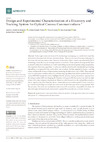Please use this identifier to cite or link to this item:
https://accedacris.ulpgc.es/handle/10553/107076
| DC Field | Value | Language |
|---|---|---|
| dc.contributor.author | Mederos-Barrera, Antonio | en_US |
| dc.contributor.author | Jurado Verdú, Cristo Manuel | en_US |
| dc.contributor.author | Guerra Yánez, Víctor | en_US |
| dc.contributor.author | Rabadán, José A. | en_US |
| dc.contributor.author | Perez-Jimenez, Rafael | en_US |
| dc.date.accessioned | 2021-05-03T11:53:59Z | - |
| dc.date.available | 2021-05-03T11:53:59Z | - |
| dc.date.issued | 2021 | en_US |
| dc.identifier.issn | 1424-8220 | en_US |
| dc.identifier.other | Scopus | - |
| dc.identifier.uri | https://accedacris.ulpgc.es/handle/10553/107076 | - |
| dc.description.abstract | Visible light communications (VLC) technology is emerging as a candidate to meet the demand for interconnected devices’ communications. However, the costs of incorporating specific hardware into end-user devices slow down its market entry. Optical camera communication (OCC) technology paves the way by reusing cameras as receivers. These systems have generally been evaluated under static conditions, in which transmitting sources are recognized using computation-ally expensive discovery algorithms. In vehicle-to-vehicle networks and wearable devices, tracking algorithms, as proposed in this work, allow one to reduce the time required to locate a moving source and hence the latency of these systems, increasing the data rate by up to 2100%. The proposed receiver architecture combines discovery and tracking algorithms that analyze spatial features of a custom RGB LED transmitter matrix, highlighted in the scene by varying the cameras’ exposure time. By using an anchor LED and changing the intensity of the green LED, the receiver can track the light source with a slow temporal deterioration. Moreover, data bits sent over the red and blue channels do not significantly affect detection, hence transmission occurs uninterrupted. Finally, a novel experimental methodology to evaluate the evolution of the detection’s performance is proposed. With the analysis of the mean and standard deviation of novel K parameters, it is possible to evaluate the detected region-of-interest scale and centrality against the transmitter source’s ideal location. | en_US |
| dc.language | eng | en_US |
| dc.relation | Arquitecturas Opticas Hibridas Para Ciudades Inteligentes | en_US |
| dc.relation.ispartof | Sensors (Switzerland) | en_US |
| dc.source | Sensors [ISSN 1424-8220], v. 21 (9), 2925, (Mayo 2021) | en_US |
| dc.subject | 3325 Tecnología de las telecomunicaciones | en_US |
| dc.subject.other | Detection System | en_US |
| dc.subject.other | Discovery System | en_US |
| dc.subject.other | K Parameters | en_US |
| dc.subject.other | Optical Camera Communications | en_US |
| dc.subject.other | Test System For Tracking Systems | en_US |
| dc.subject.other | Tracking System | en_US |
| dc.title | Design and experimental characterization of a discovery and tracking system for optical camera communications | en_US |
| dc.type | info:eu-repo/semantics/Article | en_US |
| dc.type | Article | en_US |
| dc.identifier.doi | 10.3390/s21092925 | en_US |
| dc.identifier.scopus | 85104526049 | - |
| dc.contributor.authorscopusid | 57220806560 | - |
| dc.contributor.authorscopusid | 57204424115 | - |
| dc.contributor.authorscopusid | 55650664600 | - |
| dc.contributor.authorscopusid | 6701924182 | - |
| dc.contributor.authorscopusid | 56044417600 | - |
| dc.identifier.issue | 9 | - |
| dc.relation.volume | 21 | en_US |
| dc.investigacion | Ingeniería y Arquitectura | en_US |
| dc.type2 | Artículo | en_US |
| dc.description.notas | This article belongs to the Special Issue Visible Light Communication, Networking, and Sensing | en_US |
| dc.utils.revision | Sí | en_US |
| dc.date.coverdate | Mayo 2021 | en_US |
| dc.identifier.ulpgc | Sí | en_US |
| dc.contributor.buulpgc | BU-TEL | en_US |
| dc.description.sjr | 0,803 | |
| dc.description.jcr | 3,847 | |
| dc.description.sjrq | Q1 | |
| dc.description.jcrq | Q1 | |
| dc.description.scie | SCIE | |
| dc.description.miaricds | 10,8 | |
| item.grantfulltext | open | - |
| item.fulltext | Con texto completo | - |
| crisitem.project.principalinvestigator | Pérez Jiménez, Rafael | - |
| crisitem.author.dept | GIR IDeTIC: División de Fotónica y Comunicaciones | - |
| crisitem.author.dept | IU para el Desarrollo Tecnológico y la Innovación | - |
| crisitem.author.dept | GIR IDeTIC: División de Fotónica y Comunicaciones | - |
| crisitem.author.dept | IU para el Desarrollo Tecnológico y la Innovación | - |
| crisitem.author.dept | Departamento de Señales y Comunicaciones | - |
| crisitem.author.dept | GIR IDeTIC: División de Fotónica y Comunicaciones | - |
| crisitem.author.dept | IU para el Desarrollo Tecnológico y la Innovación | - |
| crisitem.author.dept | Departamento de Señales y Comunicaciones | - |
| crisitem.author.orcid | 0000-0002-7371-5563 | - |
| crisitem.author.orcid | 0000-0002-6264-7577 | - |
| crisitem.author.orcid | 0000-0002-9994-4495 | - |
| crisitem.author.orcid | 0000-0002-8849-592X | - |
| crisitem.author.parentorg | IU para el Desarrollo Tecnológico y la Innovación | - |
| crisitem.author.parentorg | IU para el Desarrollo Tecnológico y la Innovación | - |
| crisitem.author.parentorg | IU para el Desarrollo Tecnológico y la Innovación | - |
| crisitem.author.fullName | Jurado Verdu, Cristo Manuel | - |
| crisitem.author.fullName | Guerra Yanez, Victor | - |
| crisitem.author.fullName | Rabadán Borges, José Alberto | - |
| crisitem.author.fullName | Pérez Jiménez, Rafael | - |
| Appears in Collections: | Artículos | |
SCOPUSTM
Citations
9
checked on Jun 8, 2025
WEB OF SCIENCETM
Citations
7
checked on Jun 8, 2025
Page view(s)
201
checked on Nov 30, 2024
Download(s)
135
checked on Nov 30, 2024
Google ScholarTM
Check
Altmetric
Share
Export metadata
Items in accedaCRIS are protected by copyright, with all rights reserved, unless otherwise indicated.
